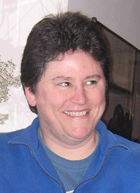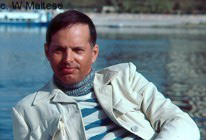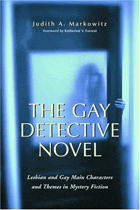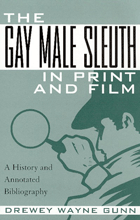
 Writers
Lori L. Lake and William Maltese review two different books on the
subject glbt detective novels. A side-by-side comparison renders an
unusual opportunity for writers of the detective novel genre.
Writers
Lori L. Lake and William Maltese review two different books on the
subject glbt detective novels. A side-by-side comparison renders an
unusual opportunity for writers of the detective novel genre.Lori reviews The Gay Detective Novel: Lesbian and Gay Main Characters and Themes in Mystery Fiction
By Judith A. Markowitz
William reviews THE GAY MALE
SLEUTH IN PRINT AND FILM:
A HISTORY AND ANNOTATED
BIBLIOGRAPHY
by Drewey Wayne Gunn
  The Gay Detective Novel: Lesbian and Gay
Main Characters and Themes in Mystery Fiction The Gay Detective Novel: Lesbian and Gay
Main Characters and Themes in Mystery Fictionby Judith A. Markowitz McFarland, www.mcfarlandpub.com ISBN: 0786419571 $35.00 312 pgs Judith Markowitz’s compendium of information about modern novels containing gay and lesbian characters and themes is one terrific book. Focusing on mystery fiction (not so much thrillers or other sorts of crime fiction), the bulk of the book contains five major sections: Police, PIs, Pro Sleuths, Amateur Sleuths, and Partners, all within the section entitled "The Authors & Their Characters." Markowitz quotes many authors (such as Katherine V. Forrest, RD Zimmerman, Joseph Hansen, Val McDermid, and many more), all of whom give unique insight into the creation of characters and the way that themes are illuminated. The information about the authors and their intents and themes is fascinating. Markowitz has broken down all the books into various topics and listed out which novels talk about which themes. This results in an extensive, ably organized section detailing the themes across various series. I soon saw clearly that: 1) gay and lesbian mysteries contain a huge variety of themes and subplots rarely dealt with in mainstream novels; and 2) gay detective fiction is usually not just about detection but also about the nature of crimes – often against gay people - and the society in which such offenses are committed. The worlds in which these investigations take place are broad and varied, and it’s not just coming out or homophobia or gay rights that authors deal with. Markowitz’s list of themes includes everything from Adoption and Age to Hustling, Erotica, S/M, Bashing, Youth Issues, AIDS, Outing, and more. The intersection of a crime or injustice with the attempt by a sleuth to discover and right the wrong often makes for complex plots and subplots in gay and lesbian fiction. The book includes notes, bibliography, an index, and a Foreword by Katherine V. Forrest. All in all, it's a good collection which covers many standalone mysteries and most of the gay and lesbian series books for the last 40-50 years. This is one resource book that any library, crime fiction writer, or mystery fan will want on their shelves! —Lori L. Lake
Gay and Lesbian Mysteries
An Incomplete, Ever-expanding, Totally Subjective Listing by Lori L. Lake, Listed by author name, (sleuth series/name), BOOK TITLE(s) Please Note: If you find other titles that are so excellent you know I should read them, please drop me a line at Lori@LoriLLake.com. Or visit my site. |
  THE
GAY MALE SLEUTH IN PRINT AND FILM: A HISTORY AND ANNOTATED BIBLIOGRAPHY THE
GAY MALE SLEUTH IN PRINT AND FILM: A HISTORY AND ANNOTATED BIBLIOGRAPHYby Drewey Wayne Gunn ISBN: 0810856816 Scarecrow Press, Inc. Reviewed by William Maltese (http://www.williammaltese.com) whose sci-fi epic BOND-SHATTERING has just been released). Why do I so like/enjoy Drewey Wayne Gunn’s just-released reference book, THE GAY MALE SLEUTH IN PRINT AND FILM — and why should every aficionado of the mystery genre rush out and buy one? Let me count the ways: [1] For anyone (whether reader or writer) interested in the gay male sleuth as a fictional genre, this book is, by far, the most comprehensive work to date. Granted, there have been other reference books that have included the subject (Anthony Slide’s GAY AND LESBIAN CHARACTERS AND THEMES IN MYSTERY NOVELS: A CRITIAL GUIDE TO OVER 500 WORKS IN ENGLISH comes immediately to mind), but you’re not, at least today, going to get a more up-to-date and complete history of the gay detective, in film and fiction, than you get right here. [2] The author, a professor emeritus at Texas A&M University-Kingsville, and author of several articles and books, including MEXICO IN AMERICAN AND BRITISH LETTERS and TENNESSEE WILLIAMS, unabashedly gives credit where credit is due, namely emphasizing the prime importance of gay pulp fiction in the early developmental stages of the mystery (gay and/or straight) novel. As Professor Gunn insightfully points out in his book: “One hardly knows whether to be pleased that so much has already been noted or to be frustrated at how gay mysteries continue to be doubly marginalized — first because mysteries receive only so much respect anyway, doubly because gay mysteries seem to receive even less.” [3] The book is chockablock with useful and interesting information. Like how there are plausible reasons to conclude that Sherlock Holmes was gay… Like how the first recognizably gay sleuth probably appeared in Rodney Garland’s English novel THE HEART IN EXILE (1953)... Like how some books titles that don’t even sound as if they are gay detective novels (THE BUTTERSCOTCH PRINCE by Richard Hall, ADONIS by William J. Lambert III) are, in fact, gay detective novels. .. Like how Don Holliday (author of THE MAN FROM C.A.M.P. series), is really Victor Banis, and how John Jackson (DEADLY ORGASM) is really Tom Norman... Like how a book by one author (A ROTTEN WAY TO DIE by Brenner Luckhart can end up confusedly reprinted under a different title (BODY EMBEZZLERS) and authorship (Joseph Shalam)…. [4] What better reason for me personally to buy this book that to find myself (including several of my pseudonyms) not once, not twice, but several times mentioned within the text and Index? What fun to have become, once again, a “reference”. Not to mention how interesting it was for me to be coaxed into remembering just how many books I did write in the gay-sleuth genre. And, how can I resist an author and book that has such probative things to say about my E-MISSION?: “Brad Winslow, the hero of E-Mission (1974) … is only posing as a secret agent. But his impersonation becomes a cogent study of the way legally mandated closets so easily create double agents.” [5] The book is written in a language surprisingly un-stuffy for a reference book. Granted, sentences like the following can be a tad daunting: “Slowly I became aware that his cognitive processes function as a paradigm of the stages of self-actualization all gay men must go through if we are to achieve wholeness in our lives.” That said, the majority of Professor Gunn’s writing is a more accessibly down-to-earth, like: “As he ages, he does begin to worry that sex is addictive, especially when he realizes he cannot remember his last eight or ten partners.” [6] Finally, if you’re ever in a good mood for a gay detective novel, but you haven’t a clue what’s “out there” for your reading pleasure, you need look no farther than Professor Gunn’s THE GAY MALE SLEUTH IN PRINT AND FILM. It just doesn’t get any easier than this. —William Maltese
|